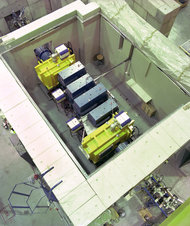Production of new elements – the idea
To produce a new element scientists use two elements naturally occuring on Earth. They fuse the two nuclei to a new much larger and heavier nucleus. The new element is the sum of the two constituents. The element 110 (Darmstadtium) was for example produced by fusion of nickel (element 28) with lead (element 82) (28+82=110).
The production
GSI scientists accelerate electrically charged atoms, so called ions, of one element with a 120 meters long accelerator to a high speed. Then they shoot them with approx. 30.000 kilometers per hour onto the other element. The repulsing force between the two nuclei can be overcome by the high speed and they can fuse to a new element.
Filter/Separation
After the production the scientists have to prove that they really made a new element. First the element is propelled out of the reaction zone with many other fragments produced in the reaction. With different methods the scientists filter (or separate) the new element. Only then they can detect it.
Detection
To prove the production of a new element scientists use the fact that the new element is unstable. It decays into another, lighter element after just the fraction of a second and emits an alpha particle. This process can repeat several times. A so-called decay chain appears. The scientists detect the alpha particles of the decay chain and thus can verify the existence of the new element.
Experimental setups at GSI
Scientists use two complementing experimental setups for the investigation of new elements at GSI.
SHIP (Separator for Heavy Ion reaction Products)
Discovery of elements 107-112 / Production of element 116
in operation since 1976
SHIP is a so-called velocity filter. Using a combination of very strong electrical and magnetical fields it separates the electrically charged reaction products flying through vacuum according to their different velocities. After the separation the new element is stopped in a semiconductor detector made of silicium and identified by measuring its alpha radiation.
TASCA (TransActinide Separator and Chemistry Apparatus)
Production of elements 113-115, 117
in operation since 2006
TASCA is a so-called gas-filled separator. The reaction products fly through a strongly dilluted gas. The gas causes, among other things, that different reaction products each gain an identical charge state. It leads to as many atoms of the element as possible moving on a similar trajectory through a magnetic field. The trajectories of other reaction products differ, so that they are spatially parted from another. The element is stopped in a semiconductor detector made of silicium at the end of the separator and identified by measuring its alpha radiation. With further detectors even an analysis of the chemical properties of new elements is possible.















